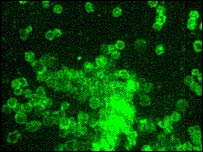10 bacteria are enough to cause the death of a person

Experts have managed to decipher the complex DNA sequence of one of the most dangerous creatures known to science. The bacterium Francisella tularensis is a sure candidate to be used as a biological weapon, because only ten bacteria are enough to make a person sick and in most cases die from the disease.
The work of deciphering the genome sequence of the bacterium is a step in the accelerated research to find a vaccine against the bacterium. An international team, which also included scientists from the British Ministry of Defense, reported the findings in the journal Nature Genetics.
"There is no other pathogen that I can think of that is more contagious," said Prof. Richard Titball, from the Defense Ministry's Science and Technology Laboratory in Porton Down, UK and one of the authors of the article.
"There are two other bacteria playing on the same field and they are also candidates to be used as biological weapons." said.
The bacterium causes a disease called tularemia or rabbit fever in humans and animals. It is high on the biological agencies' watch list and experts fear that it could be used in terrorist attacks.
Until recently, there was not much public health concern in the UK because this bacterium did not cause many cases of illness in the British population. said Prof. Bill Keville, a microbiologist at the University of Southampton in the UK. "However, it is clear that from the terrorist angle, we have a greater interest now."
Natural cases of infection occur in North America, Europe and Asia when humans are exposed to the bites of flies or mosquitoes or inhale particles in the air (aerosols).
An outbreak that happened at Martha's Winery in the US in 2000 happened when someone walked over a rabbit carcass with a lawnmower. The bacteria floating in the air hit two people.
The World Health Organization has estimated that an aerial dispersion of 50 kg of F.tularensis over an urban area where five million people live will cause the death of 19 thousand people and the illness of at least 250 thousand. "Even those who do not die, will suffer from chronic diseases for weeks and months. It's a disease that makes people feel really sick." Prof. Titball told the BBC. Now there is hope that the work of deciphering the genetic sequence, which took five years, will start an international protection program against F.tularensis, and will lead to the development of a new vaccine and tools to identify the disease.
used by the Soviets
The researchers from Great Britain, the United States and Swedish institutes said that they had already located protein targets to create a vaccine. They also found an unusual gene cluster likely involved in causing the disease. Strangely, this sequence has not yet been seen in any other living creature. The scientists do not know how F.tularensis acquired them and how they work. However, according to Prof. Titbol, their presence in an unknown way caused the bacteria to cause diseases.
Tularemia was first described as an epidemic-like disease of rodents in 1911 and as a potentially fatal disease in humans shortly thereafter. The Japanese were the first to study the bacterium as a candidate for biological weapons in a program that lasted from 1932 until their defeat in 1945.
Ken Alibek, a former Soviet biological weapons scientist, speculated that the Red Army may have used tularemia against German forces on the Eastern European front during World War II. The US military turned this bacterium into a weapon during the XNUMXs and XNUMXs. A parallel Soviet effort continued, according to experts, until the early XNUMXs. It is not known if the countries that split from the Soviet Union continue to have stocks of the bacteria.
